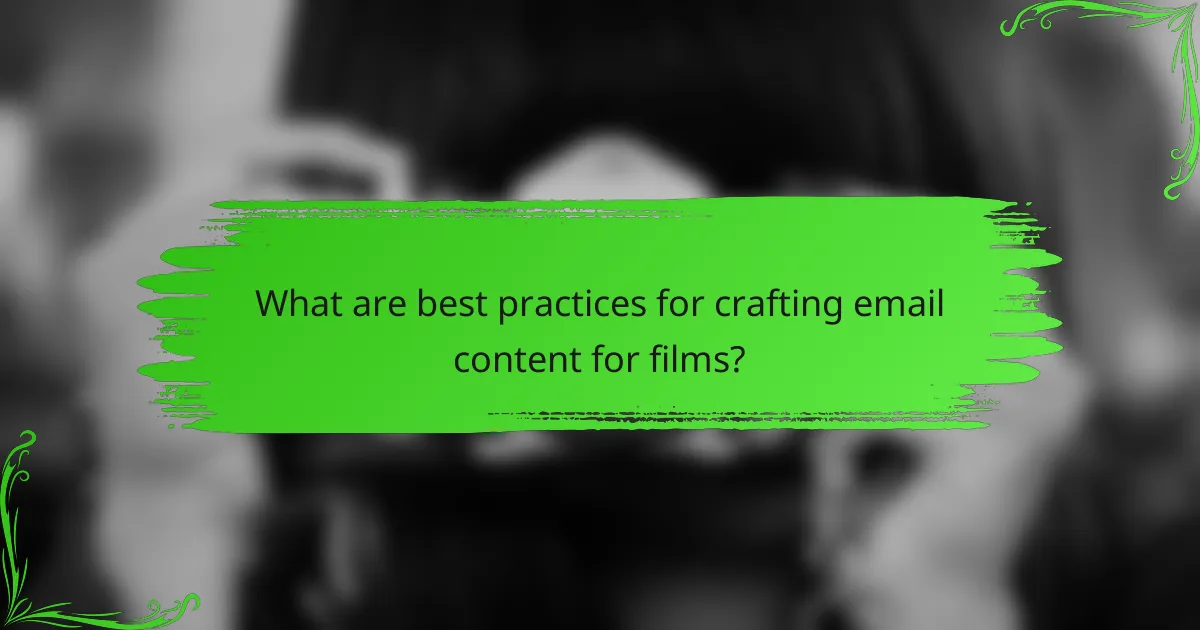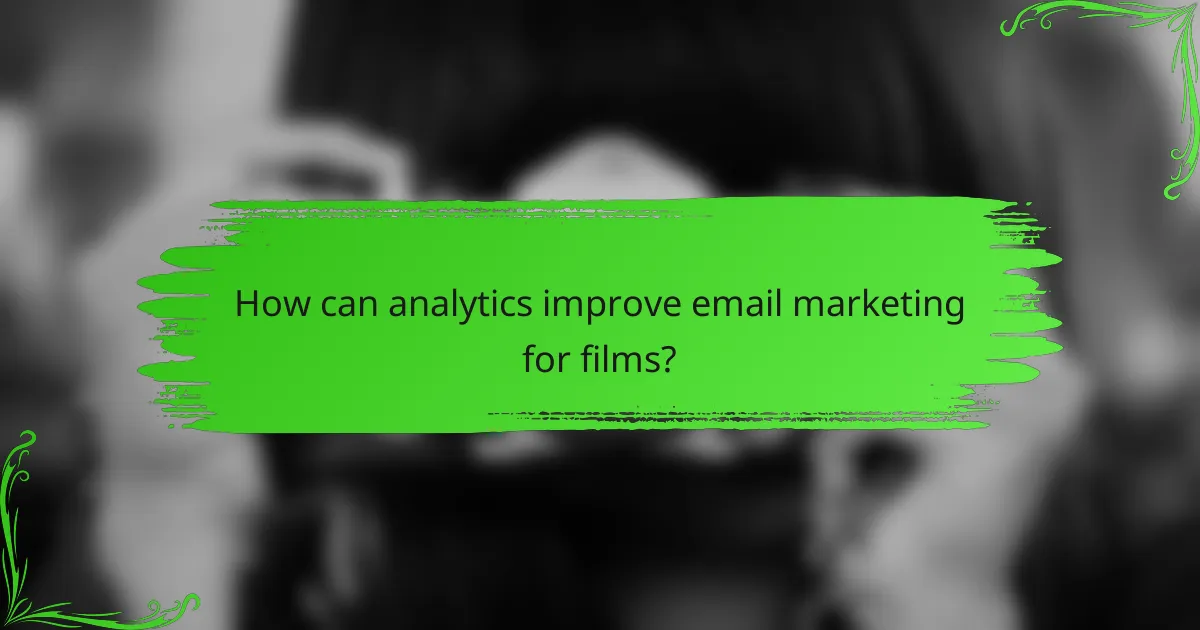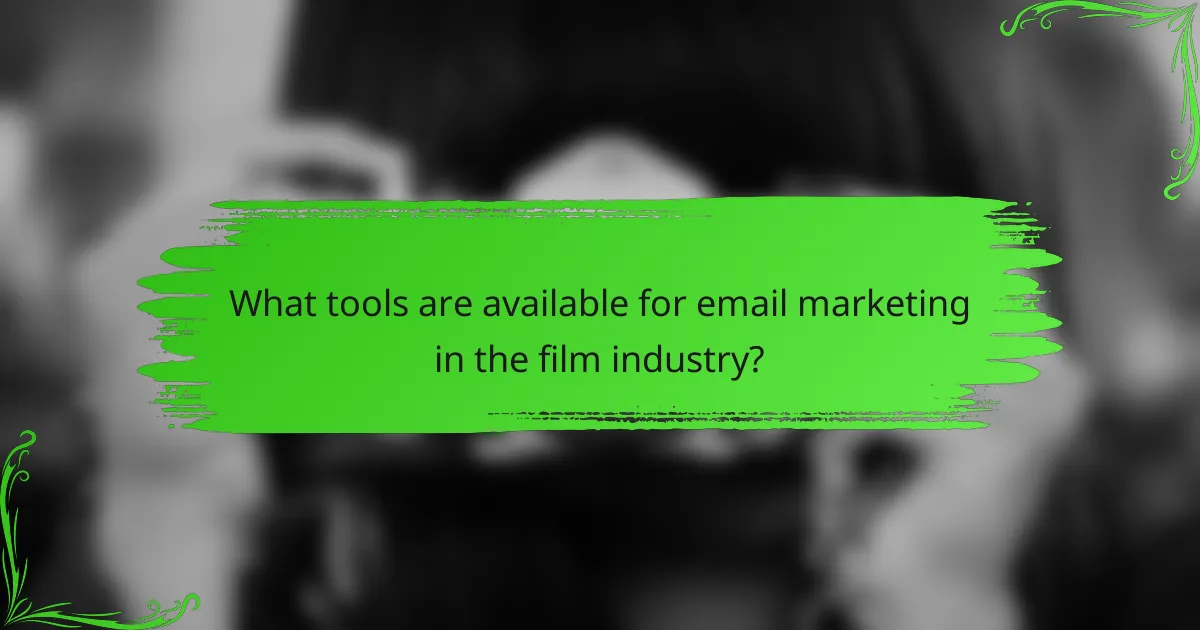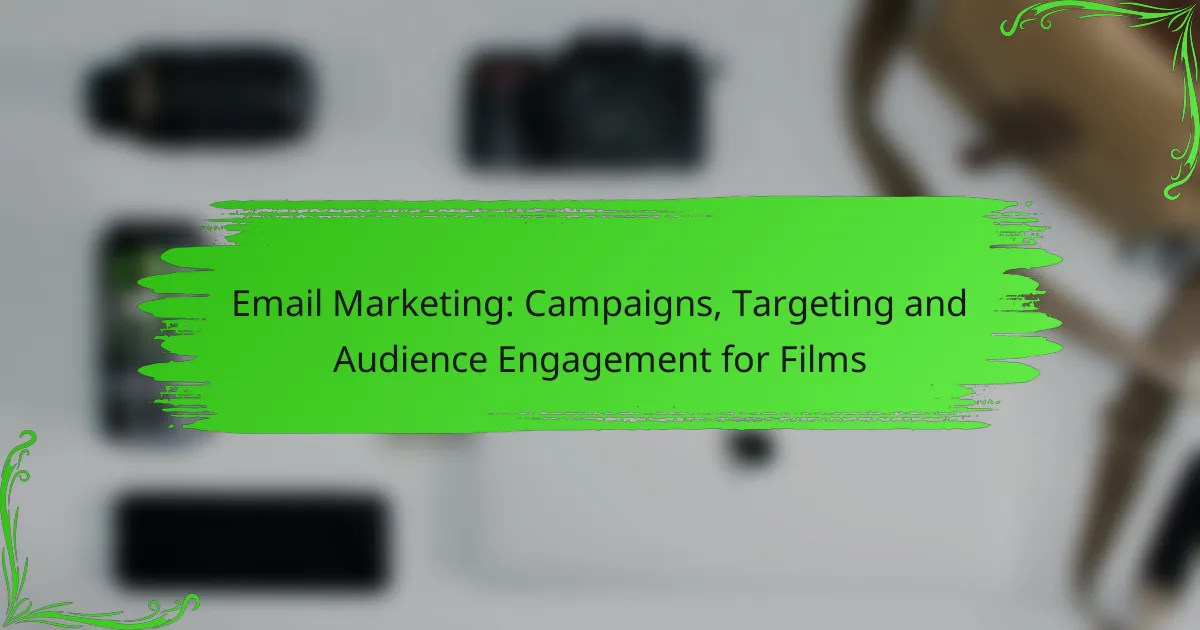Email marketing campaigns are a powerful tool for filmmakers to engage directly with their audiences, fostering excitement and anticipation for upcoming releases. By employing targeted messaging and personalized content, filmmakers can effectively connect with potential viewers based on their demographics and behaviors. Crafting visually appealing and engaging email content, complete with compelling storytelling and clear calls to action, is essential for maximizing audience engagement and driving conversions.

How can email marketing campaigns boost film engagement?
Email marketing campaigns can significantly enhance film engagement by directly connecting filmmakers with their audience. Through targeted messaging and personalized content, these campaigns can create excitement and anticipation around film releases.
Increased audience reach
Email marketing allows filmmakers to reach a broader audience by leveraging existing subscriber lists and encouraging sign-ups through various channels. By segmenting audiences based on interests, demographics, or past engagement, filmmakers can tailor their messages to resonate with specific groups.
For instance, a film targeting young adults might use vibrant visuals and social media integration in its emails, while a documentary may adopt a more informative tone. This targeted approach can lead to higher open and click-through rates, effectively expanding the film’s reach.
Enhanced ticket sales
Email campaigns can directly drive ticket sales by including clear calls to action and exclusive offers. By promoting early bird discounts or limited-time promotions, filmmakers can create urgency that encourages immediate purchases.
For example, sending an email with a countdown timer for ticket sales can motivate fans to act quickly. Additionally, integrating ticket purchasing links within the email simplifies the process, reducing barriers to conversion.
Improved brand loyalty
Consistent email communication fosters a sense of community and loyalty among film audiences. By sharing behind-the-scenes content, interviews, and updates, filmmakers can keep their audience engaged and invested in their projects.
Offering exclusive content or rewards for subscribers, such as sneak peeks or merchandise discounts, can further strengthen this loyalty. Regularly engaging with fans through personalized emails helps build a lasting relationship, encouraging them to support future projects as well.

What are effective targeting strategies for film audiences?
Effective targeting strategies for film audiences involve segmenting your audience based on specific characteristics, behaviors, and locations. By understanding your audience’s demographics, behaviors, and geographic locations, you can tailor your email marketing campaigns to resonate more deeply with potential viewers.
Segmentation by demographics
Demographic segmentation involves categorizing your audience based on age, gender, income, and education level. For films, this can help identify which groups are most likely to engage with specific genres or themes. For example, a romantic comedy may appeal more to younger audiences, while historical dramas might attract older viewers.
To implement demographic targeting, collect data through sign-up forms, surveys, or social media interactions. Use this information to create tailored email lists, ensuring that your messaging aligns with the interests and preferences of each demographic group.
Behavioral targeting
Behavioral targeting focuses on the actions and engagement patterns of your audience. This can include their previous interactions with your emails, website visits, and social media engagement. By analyzing these behaviors, you can send personalized content that encourages further engagement, such as reminders for upcoming screenings or exclusive behind-the-scenes content.
Utilize tracking tools to monitor user behavior and segment your audience accordingly. For instance, if a subscriber frequently clicks on action film trailers, consider sending them updates on new action releases or related merchandise.
Geolocation targeting
Geolocation targeting allows you to tailor your email campaigns based on the physical location of your audience. This is particularly useful for promoting local screenings, events, or film festivals. By understanding where your audience is located, you can send targeted messages that highlight relevant content and encourage attendance.
To effectively implement geolocation targeting, use location data from email sign-ups or website interactions. For example, if a film is premiering in a specific city, send a targeted email to subscribers in that area, offering them exclusive discounts or early access to tickets.

What are best practices for crafting email content for films?
Best practices for crafting email content for films include creating engaging and visually appealing messages that resonate with your audience. Focus on storytelling, clear calls to action, and compelling subject lines to drive engagement and conversions.
Compelling subject lines
Compelling subject lines are crucial for capturing your audience’s attention and increasing open rates. Aim for concise, intriguing phrases that hint at the film’s content or evoke curiosity. For example, instead of “New Film Release,” try “Experience the Thrill of Our Latest Adventure!”
Consider personalizing subject lines with the recipient’s name or interests to make them feel more relevant. Avoid using all caps or excessive punctuation, as these can trigger spam filters and reduce deliverability.
Visual storytelling elements
Incorporating visual storytelling elements in your email content can enhance engagement and convey the film’s essence effectively. Use high-quality images, GIFs, or short video clips that highlight key scenes or characters to draw readers in.
Ensure that visuals are optimized for fast loading and display correctly on various devices. A well-structured layout with a balance of text and images can keep the audience interested and encourage them to explore more about the film.
Clear calls to action
Clear calls to action (CTAs) guide your audience on what to do next, whether it’s watching a trailer, purchasing tickets, or sharing the email. Use action-oriented language and make CTAs visually distinct, such as buttons or bold text.
Position CTAs strategically within the email, ideally at the beginning and end, to maximize visibility. Test different wording and placements to determine what resonates best with your audience and leads to higher conversion rates.

How can analytics improve email marketing for films?
Analytics can significantly enhance email marketing for films by providing insights into audience behavior and engagement. By tracking key metrics, filmmakers can tailor their campaigns to better resonate with their target audience, ultimately driving ticket sales and increasing viewership.
Tracking open rates
Open rates indicate the percentage of recipients who opened an email, serving as a crucial metric for assessing the effectiveness of subject lines and send times. A typical open rate for film-related emails might range from 15% to 30%, depending on the audience and content quality. Monitoring this metric helps identify trends and optimize future campaigns.
To improve open rates, consider A/B testing different subject lines and sending emails at various times to see what works best for your audience. Avoid using misleading subject lines, as this can lead to higher unsubscribe rates.
Measuring click-through rates
Click-through rates (CTR) reflect the percentage of recipients who clicked on links within the email, providing insight into the effectiveness of the email’s content and calls to action. A good CTR for email campaigns in the film industry typically falls between 2% and 5%. This metric helps gauge how well the email engages the audience.
To boost CTR, ensure that your emails include clear and compelling calls to action, such as “Watch the Trailer” or “Get Tickets Now.” Use visually appealing layouts and limit the number of links to focus attention on the most important actions.
Analyzing audience feedback
Audience feedback, collected through surveys or direct responses, offers valuable insights into viewer preferences and perceptions. This qualitative data can guide future marketing strategies and content creation, helping filmmakers understand what resonates with their audience. Consider using simple feedback forms or polls to gather opinions after a campaign.
Encourage feedback by offering incentives, such as discounts on future tickets or exclusive content. Be sure to analyze the feedback regularly to identify patterns and adjust your marketing approach accordingly, ensuring it aligns with audience expectations and interests.

What tools are available for email marketing in the film industry?
Several tools cater specifically to email marketing in the film industry, focusing on campaign management, audience engagement, and analytics. These platforms help filmmakers and studios effectively reach their target audiences and promote their films through tailored email campaigns.
Mailchimp for campaign management
Mailchimp is a popular choice for managing email campaigns in the film sector due to its user-friendly interface and robust features. It allows users to create visually appealing emails, segment audiences, and automate campaigns, making it easier to engage with fans and potential viewers.
When using Mailchimp, consider its tiered pricing structure based on the number of subscribers and features needed. For small to mid-sized film projects, the free plan offers essential tools, while larger productions may benefit from paid plans that include advanced analytics and A/B testing capabilities.
Constant Contact for audience engagement
Constant Contact excels in fostering audience engagement, providing tools for surveys, event registrations, and social media integration. This platform is particularly beneficial for film promotions, allowing filmmakers to gather feedback and build a community around their projects.
Utilizing Constant Contact can enhance your email marketing strategy by leveraging its customizable templates and easy-to-use campaign builder. Keep in mind that its pricing is based on the number of contacts, so plan your budget accordingly to ensure you can maintain effective communication with your audience.
